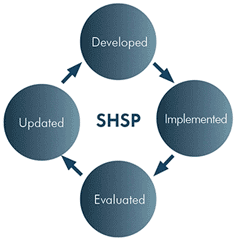The SHSP is a critical part of the Highway Safety Improvement Program (HSIP), which is a core Federal-aid program designed to achieve significant reductions in traffic fatalities and serious injuries. It requires a data-driven strategic approach to improving traffic safety. The SHSP has been included in three of the most recent transportation bills which provide funding for transportation across the U.S., including the Safe, Accountable, Flexible, Efficient Transportation Equity Act: A Legacy for Users (SAFETEA-LU); the Moving Ahead for Progress in the 21st Century (MAP-21), and the Fixing America’s Surface Transportation (FAST) Act, which continues the requirement for States to develop, implement, evaluate, and update an SHSP “that identifies and analyzes highway safety problems and opportunities on all public roads.”

Source: Cambridge Systematics, Inc.
The SHSP is developed by the State transportation department. It is a data-driven, statewide coordinated plan that provides a comprehensive framework for reducing traffic-related fatalities and serious injuries across all modes, and on all public roadways. It is designed to drive safety investment decisions and be coordinated with other safety plans, including the Highway Safety Improvement Program (HSIP), the Highway Safety Plan (HSP), and the Commercial Vehicle Safety Plan (CVSP).
States were required to develop SHSPs in 2005. By October 1, 2007 all States complied. This means if you currently are involved in your SHSP, it will be either during the implementation, update, or evaluation stage, which are described in this guide.
The SHSP process is continuous with one element always building on the other as the effort moves forward. As States implement their plans, they are gathering information for the evaluation of the plan, and the results from the evaluation will guide the update process showing where changes are needed in the future.
Benefits of SHSPs
The primary goal of an SHSP is to reduce fatalities and serious injuries on all public roads. It offers the following benefits:
- Establishes common statewide goals and priorities;
- Strengthens existing partnerships;
- Builds new safety coalitions;
- Promotes data, knowledge, and resource sharing;
- Focus on the State’s most serious traffic safety problems;
- Avoids redundant activities and leverages existing resources, such as funding, personnel, and leadership;
- Provides a multidisciplinary approach to solving problems; and
- Incorporates both behavioral and infrastructure strategies and countermeasures to more effectively reduce highway fatalities and serious injuries on all public roads.
“The true benefit of the plan is getting lots of organizations collaborating on safety goals and investments. This has been invaluable. It strengthens the individual organizations, reduces duplication and stretches human and financial resources farther.”
W. Scott Jones, Utah Department of Transportation
Involvement in the SHSP means one organization does not carry all of the financial or technical burdens alone. It fosters camaraderie and trust, so individuals know where to turn with questions, problems, shared strategies, and new ideas. The possibilities for sharing resources through SHSP collaborations are endless. For example, high-visibility enforcement combined with low-cost safety improvements where appropriate may improve safety more than either strategy alone. The collaborative approach brings about combinations of countermeasures that more effectively improve safety than any single countermeasure.
You can learn more about the “basics” of SHSPs in the Strategic Highway Safety Plan Champion’s Guidebook. This document reviews the basic principles and important considerations concerning the development, implementation, and evaluation of an SHSP. It’s a helpful resource for States that are updating their SHSP, assessing their SHSP development process, as well as providing a reference for professionals new to the SHSP, safety or planning.
